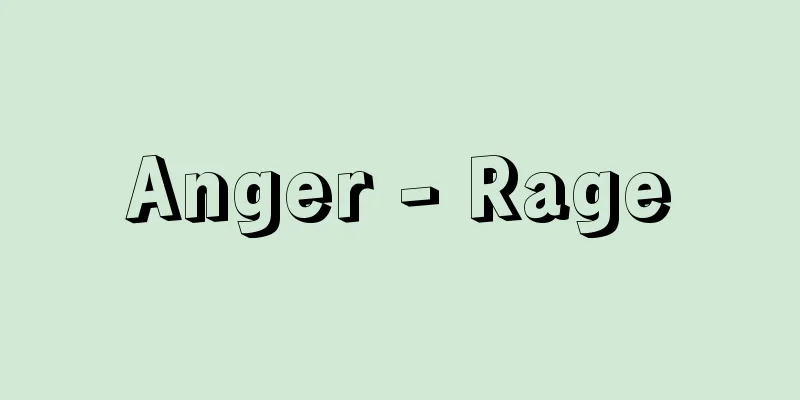Anger - Rage

|
Anger is generally considered to be an aggressive emotion that occurs when actions to reach a goal are thwarted. According to research on the differentiation of emotions by British psychologist KMB Bridges (1897-?), at birth, only excitement is present, but in infancy, pleasure and displeasure differentiate from it, and by the age of about two years old, pleasure differentiates into love and joy in addition to pleasure, and displeasure differentiates into anger and fear in addition to displeasure. By the age of five, anger gives rise to envy, jealousy, and disappointment in addition to anger, and fear gives rise to worry and shame in addition to fear. In response to this, L. Alan Sroufe explains that anger is already differentiated from displeasure in early infancy. The common thread is in infancy. At this stage, anger becomes an independent emotion. [Masao Omura] Infancy to childhoodConditions that cause anger in infants and young children include: (1) lack of exercise, hunger, fatigue, lack of sleep, physical illness, etc.; (2) excitement in the face of strong stimuli; (3) when people around them are angry (imitation behavior); and (4) when free physical movements are prohibited or restricted. Up until about age three, children express anger in a non-directional manner known as "efforts to find a solution that does not solve anything," such as crying, kicking their legs, or throwing themselves on the floor or ground. However, after age three, children begin to attack people or things that prevent them from achieving their desires. This is the beginning of the first rebellious period. After age four, verbal aggression also increases, and children may resort to insults or physical attacks. In general, boys tend to express anger in a more diverse and intense way than girls. Childhood is the elementary school age, also known as the school-age period. The conditions that cause anger during this period include (1) interference from older people or friends, (2) the infringement of one's property, (3) physical pressure, and (4) damage to one's self-esteem. As children grow and develop physically, their expressions of anger become more intense, and boys also get into more physical fights. [Masao Omura] AdolescenceIn adolescence, in addition to the anger of childhood, anger against social irrationality (public anger) and anger against one's own lack of ability and failure are added. The former is an attack on parental instructions, social conventions, and the way of looking at things and thinking that is circulating in society, and is the anger that characterizes the second rebellious period. The latter is anger that arises from a dialogue between oneself and another self that exists within oneself, and is a battle between the inner self that sharply criticizes failure and the outer self that makes excuses. It is an internal anger that emerges based on the rediscovery of the ego in adolescence. Even in adolescence, there are many physical fights in junior high school, and violence against students who are good at studying and teachers who have punished oneself, but these tendencies decrease in high school. Instead, verbal attacks, exposure of disgusting emotions, ignorance, etc. appear. In girls, negative anger is common throughout junior high and high school. It is what is commonly called bullying. A student is made a scapegoat to vent the anger that has built up against daily school life. They are generally physically weak, so their anger tends to become insidious. The personality of people who get angry easily is explosive. They get excited easily even at the slightest stimuli, and without thinking of the consequences, they injure others and damage property. Although the expression "kireru" is sometimes used, short-circuit reactions are a general characteristic of these people. [Masao Omura] [References] | | |Source: Shogakukan Encyclopedia Nipponica About Encyclopedia Nipponica Information | Legend |
|
一般に目標に到達するための行動が妨害されたときに生じる攻撃的な情動が怒りであるとされている。イギリスの心理学者ブリッジスK. M. B. Bridges(1897―?)の情動の分化についての研究によると、出生時は興奮だけであるが、乳児期にはそれから快と不快が分化し、2歳ぐらいの乳児期になると、快からは快のほかに愛情や喜びが分化し、不快からは不快のほかに怒りや恐れが分化してくるという。5歳の幼児期になると、怒りから怒りのほかに羨望(せんぼう)、嫉妬(しっと)、失望などが生まれ、恐れからは恐れのほかに心配や羞恥(しゅうち)が現れてくるという。これに対して、スルーフL. Alan Sroufeは、怒りは乳児期の初期にはすでに不快から分化していると説明している。共通しているところは乳児期である。この時期に怒りは独立した情動になっているのである。 [大村政男] 乳幼児期~児童期乳幼児期の怒りの条件としては、(1)運動不足、空腹、疲労、睡眠不足、身体的疾患などがみられるとき、(2)強い刺激に直面して興奮しているとき、(3)周囲の人たちが怒っているとき(模倣行動)、(4)自由な身体運動が禁止されたり抑制されたりしているとき、などをあげることができる。 怒りの表現としては、3歳ごろまでは泣きわめく、足をバタバタさせる、床や地面にひっくり返るといった「解決にならない解決への努力」とよばれる無方向性のものが多いが、3歳以後になると自分の欲求達成を妨害した人や事物を攻撃するようになる。第一反抗期の開幕である。4歳を過ぎるころにもなると言語による攻撃も増加し、悪口を浴びせかけたり、腕力でも攻撃するようになってくる。一般に男子のほうが女子よりも怒りの表現が多彩で、しかも激しい傾向がみられる。 児童期は小学校時代で学童期ともよばれている。この時期の怒りの条件としては、(1)年長者や友達からの干渉、(2)自分の所有物が侵害される、(3)身体的な圧迫、(4)自尊心の損傷、などがあげられる。身体的にも成長発達しているので怒りの表現も激しくなり、男子では腕力によるけんかも多くなってくる。 [大村政男] 青年期青年期になると、児童期の怒りの条件のほかに、社会的不合理に対する怒り(公憤的な怒り)や、自分の能力不足や失敗に対する怒りが加わってくる。前者は親の指示や社会的慣習、世間に流通しているものの見方や考え方に対する攻撃で、第二反抗期の特徴をなす怒りである。後者は、自分と自分のなかにいるもう1人の自分との対話から生じる怒りで、失敗を鋭く批判する内側の自分と、言い訳をする外側の自分との戦いである。青年期における自我の再発見に基づいて出現してくる内的な怒りである。青年期でも、中学生のころは腕力によるけんかが多く、勉強のできる子や自分を処罰した教師などに対する暴力もみられるが、高校生になると、このような傾向は減少してくる。そのかわりに現れてくるのが言語的な攻撃、嫌悪の情動の露出、黙殺などである。女子においては中学・高校を通して陰性な怒りが多い。俗にいういじめである。ある1人の生徒をスケープゴートにして日常の学校生活に対する積もった怒りを発散させるのである。体力的には一般にか弱いので、怒りはどうしても陰湿になりやすい。 怒りやすい人の性格としては爆発性があげられる。小さな刺激にもすぐ興奮し、前後をわきまえずに他人を傷害し器物を破損してしまう。「キレル」という表現が使われることもあるが、短絡(近道)反応は彼らの一般的特徴になっている。 [大村政男] [参照項目] | | |出典 小学館 日本大百科全書(ニッポニカ)日本大百科全書(ニッポニカ)について 情報 | 凡例 |
Recommend
stratopause
…The temperature in the lower part of the stratos...
Tradescantia blossfeldiana (English spelling)
… [Takabayashi Masatoshi]. … *Some of the termino...
Cha cha cha - Cha cha cha (English spelling)
It is a form of rhythm in popular music. It is us...
Kinshoshin
…The first full-length novel in the late Qing and...
Geddes
1854‐1932 Scottish urban planner and social econom...
Exciton
In non-metallic solids (insulators) that do not c...
Synthesis gas (English spelling)
It is a mixture of carbon monoxide and hydrogen, ...
Yerevan (English spelling) Ереван/Erevan
The capital of the Republic of Armenia. Populatio...
Cantharidae
…They overwinter as larvae and pupate in April of...
"Ganyu Pavilion Collection"
… [culture] In terms of regional cultural charact...
Parkway (English spelling)
A highway is a main road that aims to make driving...
Limassol (English spelling)
Lemesos in Greek, Lımasol in Turkish. A port city ...
Tiller - Tiller (English spelling)
Lateral branches that form at the soil edge of gra...
Open blow
In boxing, hitting with open gloves is considered ...
Tetsuji Tazoe
A socialist of the Meiji period. Born on July 24,...









